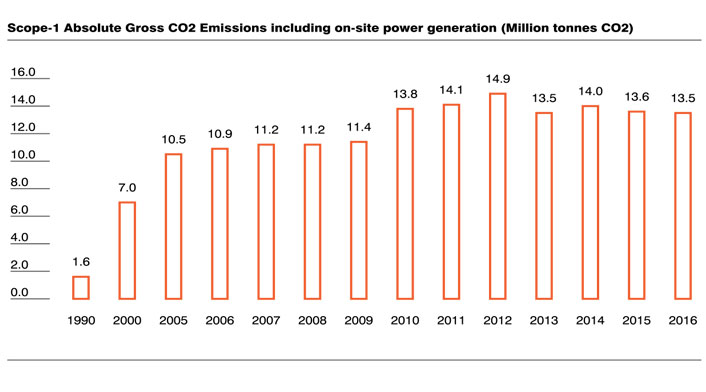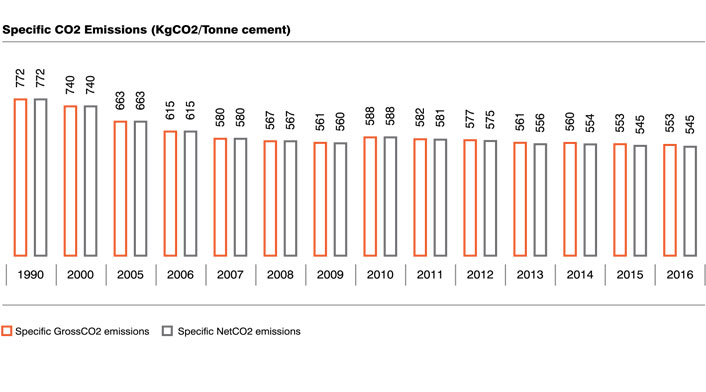Environment. Being future-ready.
Carbon and Other Emissions GRI-305
Our operations place strong focus on clean technology, energy efficiency and renewable energy. The Company’s sustainability and climate change mitigation policies reflect its commitment to sustainable development. Strategies are in place to address global warming and ensure a low carbon growth path. Environmental risks are regularly assessed and addressed. We strive to achieve carbon footprint-conscious growth through efforts in four key facets of our operations:
- Reduction in clinker factor by use of appropriate materials like fly ash and slag;
- Improving thermal energy efficiency and process technology;
- Optimising fuel composition, including the use of wastes as alternative fuels.
Fly ash-based PPC is our main product and remains a priority. We have also started producing composite cement which uses both fly ash and slag. Our renewable energy portfolio has been performing well and helping us reduce our carbon footprint. It includes a 15 MW biomass-based power plant at Ropar, established in 2005; a 7.5 MW wind power station in Kutch, commissioned in 2011; and a 330 KV solar power station at Bhatapara, established in 2012. The 6.5 MW WHR-based power generation system at Rajasthan, commissioned in 2015, has helped us reduce our fossil fuel-based power generation and also lessen our carbon footprint. It has been registered under the Clean Development Mechanism (CDM) of the UNFCCC to accrue 35,000 Certified Emission Reductions (CERs) per year for the next 10 years. RE and WHRS projects enabled us to reduce about 65,441 and 26,924 tonnes of CO2 respectively in 2016. Ambuja Cements Ltd. had participated in the first CDM project on the use of biomass for power generation at the Ropar plant in 2011, for which the Company earned 17,727 CERs, and a revenue of `1.60 crore. We have reduced our greenhouse gas emissions by coprocessing industrial and other wastes in our kilns as alternative fuel. This has reduced our dependence on natural resources like coal. We used about six million tonnes of fly ash in cement manufacture due to which over 91% of our overall cement production consisted of PPC.
Ambuja Cements Ltd. has been part of the Cement Sustainability Initiative (CSI) of the World Business Council on Sustainable Development (WBCSD) working group on development and implementation of a ‘Low Carbon Technology Road Map for the Indian Cement Industry’. The technical aspects mentioned in the roadmap were piloted at our Ambujanagar plant with the help of CII in 2015. The focus was on energy efficiency opportunities in the operations. As part of this partnership, we volutarily share our performance in CSI Dashboard with regard to a selection of parameters that define the aspects of sustainable development. GRI 201-2
Monitoring and Transparency Disclosures
We proactively disclose our environmental performance in accordance with CSI and GRI guidelines. The major greenhouse gas (GHG) in cement manufacture is CO2; the Company monitors and reports CO2 emissions from all manufacturing locations, including integrated cement plants, mines, and grinding units, as per the WBCSD CSI Cement CO2 and Energy Protocol (Ver3.1). Emissions from bulk cement terminals, corporate and marketing offices are insignificant and are hence excluded.
GHG Inventory includes: Scope-1: Emissions due to fuel combustion in kilns, emissions due to fuel combustion other than in kilns (e.g. on-site energy generation) and emissions due to calcination of raw materials, bypass dust and cement kiln dust etc. during clinker production; Scope-2: Emissions associated with purchased electricity from grid and emissions associated with inbound clinker.
Estimation of Scope-3 (other indirect GHG emissions) which was undertaken for all integrated plants in 2015 has now been extended to all grinding units also, thus covering all plants. Scope-3 covers emissions from purchased products and services (category-1), fuel and energy related activities (category-3), upstream and downstream transportation and distribution (category-4 & -9), waste generated in operations (category-5), business travel (category-6), and employee commuting (category-7).

The Company offers value added services like concrete mix design and modular curing services; they reduce the water usage at construction sites, bringing down the water transportation and treatment costs. Entrepreneurs are provided with technical support to manufacture and use fly ash-based bricks that consume less energy during manufacture. Ambuja Cement promotes the insulated wall concept which reduces the requirement of energy-intensive baked bricks and mortar. The Company encourages the use of manufactured sand (M-sand) and crushed sand (C-sand) to reduce the customers’ GHG emissions.
The Company’s emissions and strategies to address climate risks are disclosed annually in the Carbon Disclosure Project (CDP). The specific net CO2 per tonne of cementitious product reduced to 543 kg, down 29.6% compared to 29.4% in 2015, using 1990 levels as the baseline. The total Scope-1 (direct absolute gross CO2 emissions, including CO2 from onsite power generation) was almost static. GRI 305-5
At COP21 in December 2015 our parent LafargeHolcim declared the Group’s mission to cut net CO2 emissions by 40% per tonne of cement by 2030 (against1990 levels). This is in addition to collective sectoral action towards meeting the 2°C threshold. Besides adhering to Group-level targets, Ambuja Cement has defined its own target of CO2 emission reduction as 33% per tonne of cement (against 1990 levels) by 2020 and 40% by 2030. Efforts are on to reduce energy consumption and CO2 emissions at all stages of production through process mastery, energy efficiency measures, reduction of clinker content in cement and use of alternative energy sources.
In the captive power plants, our carbon footprint is sought to be lowered by fuel mix optimisation with alternative/low cost fuels, thermal efficiency, station heat rate (SHR) improvement, reduction in auxiliary electrical energy consumption, and better capacity utilisation.
OTHER EMISSIONS
Cement production does not emit ozone-depleting substances (ODS). SO2, NOx, dust/particulate matter and other significant emissions from all our nine kilns/ raw mill stacks are monitored by continuous emission monitoring systems (CEMS). The emissions are load calculated and reported, excluding captive power plants and other stacks. The load was not calculated on days when CEMS was not operational. In 2016, the total and specific dust and SOX emissions increased, while NOX emissions remained almost static. Ambuja Cement has initiated upgrading of pollution control systems and better operation and maintenance to control these emissions. GRI 305 (6, 7)
We have identified climate change related risks and their potential impact. Our True Value calculation of environmental and societal externalities and their effect on our EBITDA considered CO2, SO2, NOX and volatile organic compound (VOC) emissions; water extraction; land disturbances; waste generated; etc. CO2 emissions arising as a direct result of our operations remain the most significant climate change risk. Our calculations take into account the cost of all environmental and water withdrawal risks when considering the financial implications. By 2020, the estimated financial implications of the risks before taking action are projected to be about ` 3,128 million; and the cost of mitigation action is projected at about ` 10,380 million. GRI 201-2
